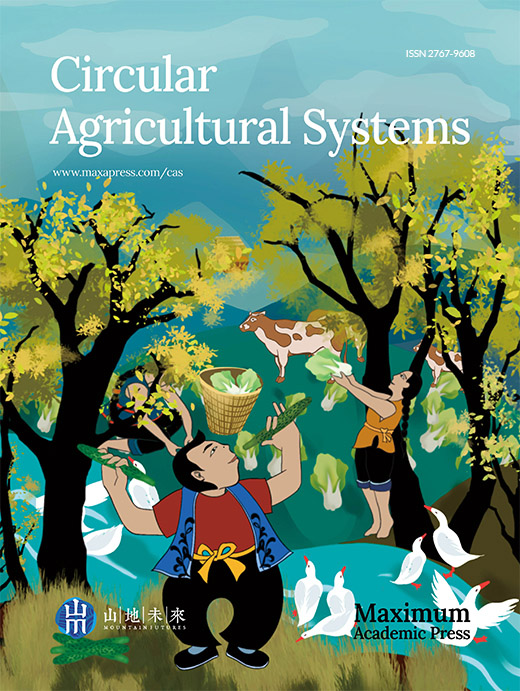-
In the 21st century, global food systems cannot remain stuck in the past. Agriculture currently contributes about one fourth of global greenhouse gas emissions and about half of all nutrient wastes annually[1]. As the number of humans on the planet continues to grow, the effects of climate change will worsen and ecosystems will continue to deteriorate. Innovation in today’s agricultural food production systems is therefore urgently needed to increase crop and animal outputs, enhance dietary diversity and improve human health while conserving environments and sustaining natural resources and cultures.
These challenges present major opportunities for the development of circular agriculture using technical innovation, institutional arrangements and profitable business models based on closed-loop biomass systems. Circular agriculture is the interdisciplinary study of the dynamic relationships between people, food and ecosystems. Circular agriculture is not new; King (1911) published a famous book titled Farmers of Forty Centuries: Organic Farming in China, Korea and Japan, which detailed the many ways in which sustainable intensification was commonly practiced in densely populated rural areas[2]. Over the decades, agricultural systems continue to be highly connected and reliant upon the interplay of plants, animals, insects, fungi and bacteria. The emergence of circular agriculture as a promising ecological alternative to mainstream agricultural systems thus represents a truly historical step. This work involves not only integrating ecological principles with agronomic practices, but also connects biologists and farmers with research from applied social scientists working on food systems. The public has a role to play, too, as people learn more about everything from healthy diets to food supply chains through the lens of sustainability — and this is already occurring as, for example, plant- and insect-based diets and other alternative proteins become increasingly fashionable. Innovative farm-field, supply and production practices based on cutting edge ecological and social science are posed to inform people about sustainable food choices with an emphasis on ecological and human health throughout the world.
Our new journal Circular Agricultural Systems (CAS) appears at a critical time to assist in publishing innovative work regarding all aspects of moving agricultural systems toward sustainability. CAS will focus on publishing interdisciplinary research and systematic solutions to solve key problems in the development of sustainable agriculture. We will highlight new methods for recirculating agricultural resources throughout value chains, targeting natural and social systems of food production, processing, distribution and consumption. CAS will also provide a crucial platform for promoting sustainable food systems research that is closely related to the United Nations Sustainable Development Goals as well as work that elucidates the complexities of food systems within the water-energy-food nexus. The CAS editorial team calls on researchers from agriculture, forestry, animal sciences, entomology, mycology, climate change, environment, soil science, as well as political ecology and political economy to contribute their expertise to a collective dialogue on agricultural systems transformation. Publishable article types include original research articles, reviews, methods, editorials and perspectives.
In this first issue, Grumbine and colleagues explore problems and prospects for circular agriculture as transformative to sustainable food systems. They identify multiple direct and indirect technical and policy options for multi-functional landscape restoration, sustainable intensification using an integrated tree-crop-livestock system and low-input smallholder farmers, along with changing the dietary habits of global consumers[3].
We also have a number of contributions on biomass-based nutrient recycling and management. In a broad Review article, Bai and colleagues argue that there is a mismatch between high animal populations (resulting in high ammonia emissions) and low feed protein self-sufficiency rates across China, potentially leading to increased environmental pollution. It is imperative to develop region-specific manure recycling and treatment strategies to address this. Composting and insect protein production show great potential to reduce solid waste pollution generated from animals in Southeast China as well as in manure storage, and in-situ field application could be applied to large-scale single cropping systems in Northwest China. In another paper, Ranjitkar and colleagues describe incorporating tree fodder material into a tree-crop-livestock system at the landscape level. Bioclimatic suitability of fodder trees largely occurs along the southern edge of agro-pastoral transitional zones ranging from Northeast to Southwest China, and incorporating fodder trees into farmland could potentially contribute to carbon-neutral agriculture. Bandara’s contribution from work in Myanmar demonstrates the potential for incorporating mushroom production into sustainable agriculture and rural development. Recycling crop residues through mushroom production could significantly reduce field burning, thereby leading to a reduction in air pollution, which threatens human health across Southeast Asia.
Our aim for all contributions to CAS is that the research addresses (directly and indirectly) major challenges in agricultural systems as more attempts are made to improve ecosystem and human health. Manuscripts should convey not only applied research but concrete actions capable of linking business models with rural development. We believe that a wide range of simple, low-cost interventions at the farm and landscape levels could vastly improve nutrient use efficiency, address excess amounts of agricultural waste and recycle on-farm nutrients across multiple scales. Equally important, there is a pressing need to re-examine social and institutional arrangements of food systems, especially regarding how to promote change in land management within coupled social-ecological systems. Multi-scale, cross-sectoral recycling and reuse systems will require contributions from a broad range of actors and local communities, governments and the private sector, as well as a more informed understanding of the social and economic values of ecosystem services and incentives for agricultural transformations. CAS therefore welcomes all contributions on the biological, social, and cultural aspects of agricultural systems.
Welcome to Circular Agricultural Systems!
HTML
- The authors declare that they have no conflict of interest.
- Copyright: © 2021 by the author(s). Exclusive Licensee Maximum Academic Press, Fayetteville, GA. This article is an open access article distributed under Creative Commons Attribution License (CC BY 4.0), visit https://creativecommons.org/licenses/by/4.0/.
|
|












